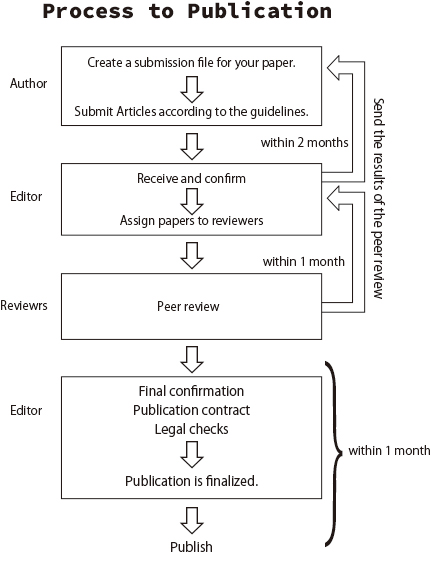Review Process
Review Process
Authors should read Author Guideline and follow their instructions to prepare your Article.
- The journal uses double-blind peer review.
- Authors must not make any statements in the text of the paper that would allow the author to be identified.
- Authors and reviewers may exchange views through the editorial office.
- The journal will have at least three reviewers reviewing your paper.
- Submitted papers will receive their first peer review within one month.
- The editors will email the first review results to the authors within two months.
- Usually, it takes two or three rounds of peer review before a decision is made on whether or not your paper will be published.
- Neither the reviewers nor the editorial office will comment on papers that are rejected.
- It is possible to resubmit an improved version of an article that has been rejected.

This is just a general process. It may not always follow this process.
Measures Against Plagiarism and Research Misconduct
The International Journal of Applied Informatics and Media Design is committed to upholding academic integrity and ensuring the reliability of published research. Preventing plagiarism and misconduct is one of our primary responsibilities. Our editorial board conducts regular checks and employs the following mechanisms and procedures to ensure the fairness and integrity of all submitted manuscripts.
1. Methods of Verification
The editorial board takes the following steps to identify potential plagiarism or misconduct:
- Plagiarism Detection Software: All submitted manuscripts are analyzed using industry-standard plagiarism detection tools (e.g., Turnitin, iThenticate). These tools objectively evaluate textual similarities with other published works to identify signs of plagiarism.
- Verification of Author Information and Data: Data sets, images, or results provided by authors are reviewed to ensure they are not fabricated or manipulated. In cases of multiple authors, we verify the appropriate attribution of contributions.
- Peer Review Process: Every manuscript undergoes a double-blind peer review process. This ensures rigorous evaluation of originality, data reliability, and citation accuracy by impartial reviewers. Reviewers carefully assess the manuscript’s originality, adherence to academic standards, and validity of the data.
2. Risk Mitigation Measures
To minimize the risk of research misconduct, the journal has implemented the following measures:
- Clear Ethical Guidelines: Our submission guidelines clearly outline ethical standards for writing and submitting academic manuscripts. This ensures authors are aware of what constitutes misconduct, such as plagiarism, duplicate submissions, data fabrication, data falsification, and inappropriate authorship attribution.
- Handling Suspected Misconduct: If plagiarism or misconduct is suspected, the editorial board conducts a prompt investigation. If necessary, the journal may retract or require corrections to the manuscript. In severe cases, the matter may be referred to the authors’ affiliated institutions for further action.
- Education and Awareness: We provide workshops and resources on academic ethics to authors and reviewers, fostering awareness and promoting preventive measures against misconduct.
3. Transparency and Continuous Improvement
The editorial board is committed to adopting the latest technologies and best practices to prevent plagiarism and misconduct. We also remain flexible in addressing emerging challenges related to academic ethics and will continue to refine our processes accordingly.
The International Journal of Applied Informatics and Media Design strives to provide a fair and reliable platform for scholarly communication. We are dedicated to maintaining an ethical academic environment for all authors, reviewers, and readers. If you have any questions or concerns, please feel free to contact our editorial team.



